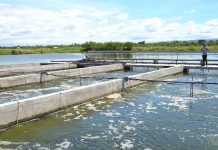THE Department of Agriculture is carrying out a five-year program to double the area planted to cassava to more than 500,000 hectares in line with its goal of attaining 100% self-sufficiency for the feed ingredient and meeting the full requirements of the cassava industry.
DA assistant secretary Dennis B. Araullo said that under the plan, the DA is targeting to increase cassava production from 1.941 million metric tons in 2008 to 10.477 million MT by 2014, which is the estimated requirement of the industry for that period.
Cassava, which can substitute as much as 20% of corn in feeds, is also used for bioethanol production and for human consumption.
Araullo, who is the national coordinator of the Ginintuang Masaganang Ani Corn Program, said the government needs to spend P26 million to P70 million a year until 2014 to reach this target of 100% sufficiency and increase areas planted to 500,000 hectares from the 230,000-hectare target in 2009.
Attaining cassava self-sufficiency, Araullo noted, will help feed millers during times of tight corn supply and possibly avoid emergency importation of corn and feed wheat.
“The government has to address a slew of challenges that threatens this goal of cassava self-sufficiency, such as low productivity, limited supply of planting materials of new and high yielding varieties and limited supply of cassava dryers and other post-harvest equipment,” Araullo said, adding, “Hence, this five-year cassava self-sufficiency plan that aims to raise the national yield average of 9 MT per hectare to 21 MT per hectare by 2014.”
He said the plan involves the establishment of postharvest equipment to increase the quality of produce in major cassava-producing regions like Northern Mindanao, Bicol, Central Visayas, and Caraga.
As part of the plan, he said the DA has propagated high-yielding cassava varieties like NSIC Cv22 (KU-50), Lakan I and Golden Yellow in 53 hectares last crop year.
“These high-yielding varieties,” Araullo said, “will help increase the national yield average to 21 MT per hectare in five years from the current nine MT per hectare.”
The Department also signed last year a P3-million deal with Visayas State University-based PhilRootscrops to produce 5.6 million cassava plantlets per year.
Araullo said the domestic demand for cassava is projected to increase to some 10 million MT in 2014 from 8.820 million MT in 2013; 7.448 million MT in 2012; 6.132 million MT in 2011; and 5.016 million MT next year, given a steady hike of demand for feeds to 8.294 million MT in 2014 from 4 million MT next year.
The hog and poultry sectors account for 79% of total domestic cassava consumption.
Data from the Bureau of Agricultural Statistics (BAS) show that cassava production rose to 1.941 million MT last year from 1.871 million MT in 2007 and 1.757 million MT in 2006, while areas planted rose to 211,633 hectares last year from 209,633 hectares in 2007 and 204,578 hectares in 2006.
Cassava imports like manioc and tapioca rose to 89,393 MT in 2007 from 58,462 MT worth in 2006, BAS data showed.
In its January-March 2009 report, BAS said that in terms of volume, the biggest gainers in the crops’ subsector were cassava with production increasing 5.08% to 405 thousand MT in the first quarter, followed by banana at 5.04% (2.024 million MT), palay, 5.13% (3.94 million MT); tomato, 3.37% (76 thousand MT), and pineapple, 3.62% 504 thousand MT).
In terms of gross values outputs, cassava came in 3rd at 32.62% to P2.106 billion. The other top grossers in the crops subsector are cabbage at 68.72% to P275 million; followed by garlic 33.74% to P769 million; palay, 26.32% to P59.66 billion; and banana, 24.61% to P19.32 billion, BAS added.[PNA]
0 Comments
Oldest






